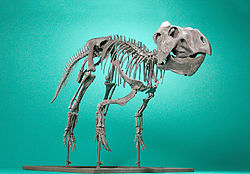Prenoceratops
| Prenoceratops | |
|---|---|

| |
| Cast of a fossil skeleton, The Children's Museum of Indianapolis | |
| Scientific classification | |
| Domain: | Eukaryota |
| Kingdom: | Animalia |
| Phylum: | Chordata |
| Clade: | Dinosauria |
| Clade: | †Ornithischia |
| Clade: | †Ceratopsia |
| Family: | †Leptoceratopsidae |
| Genus: | †Prenoceratops Chinnery, 2004 |
| Species: | †P. pieganensis
|
| Binomial name | |
| †Prenoceratops pieganensis Chinnery, 2004
| |
Prenoceratops, (meaning 'bent or prone-horned face' and derived from
Discovery and species

Prenoceratops was first discovered on a
An isolated right frontal from the Oldman Formation of southern Alberta, Canada was described in 2010 and ascribed to Prenoceratops as P. sp.[3] The fossil was found near a fossilized nesting site of Hypacrosaurus.[3]
Named Prenoceratops species include only P. pieganensis (type).[5]
Classification
Prenoceratops belonged to the Ceratopsia (which name is derived from Ancient Greek, meaning 'horned face'), a group of herbivorous dinosaurs with parrot-like beaks, which thrived in North America and Asia during the Cretaceous Period. It is closely related to Leptoceratops, which it antedates by several million years. It is characterized by a lower, more sloping head than that of Leptoceratops.
Diet
Prenoceratops, like all ceratopsians, was a herbivore. During the Cretaceous, flowering plants were "geographically limited on the landscape", and so it is likely that this dinosaur fed on the predominant plants of the era: ferns, cycads and conifers. It would have used its sharp ceratopsian beak to bite off the leaves or needles.
See also
References
- OCLC 985402380.
- ^ a b c Ryan, M. J., Evans, D. C., Currie, P. J., Brown, C. M., & Brinkman, D. (2012). New leptoceratopsids from the Upper Cretaceous of Alberta, Canada. Cretaceous Research, 35: 69-80.
- ^ a b c Miyashita, T. E. T. S. U. T. O., Currie, P. J., Chinnery-Allgeier, B. J., Ryan, M. J., Chinnery-Allgeier, B. J., & Eberth, D. A. (2010). First basal neoceratopsian from the Oldman Formation (Belly River Group), southern Alberta. In New perspectives on horned dinosaurs: the Royal Tyrrell Museum Ceratopsian Symposium. Edited by MJ Ryan, BJ Chinnery-Allgeier, and DA Eberth. Indiana University Press, Bloomington, IN (pp. 83-90).
- ISSN 0272-4634.
- ^ ISSN 0272-4634.
- Chinnery, BJ (2004). "Description of Prenoceratops pieganensis gen et sp. nov. (Dinosauria: Neoceratopsia) from the Two Medicine Formation of Montana". Journal of Vertebrate Paleontology. 24 (3): 572–590. ISSN 0272-4634.
- https://web.archive.org/web/20050225002043/http://www.vertpaleo.org/jvp/24-572-590.html (online abstract of the preceding article)
- Liddell & Scott (1980). Greek-English Lexicon, Abridged Edition. Oxford University Press, Oxford, UK. ISBN 0-19-910207-4.
